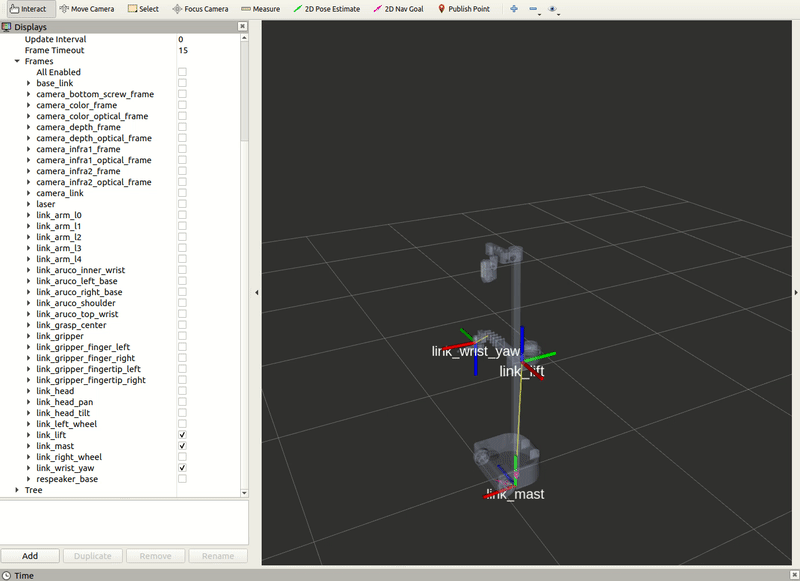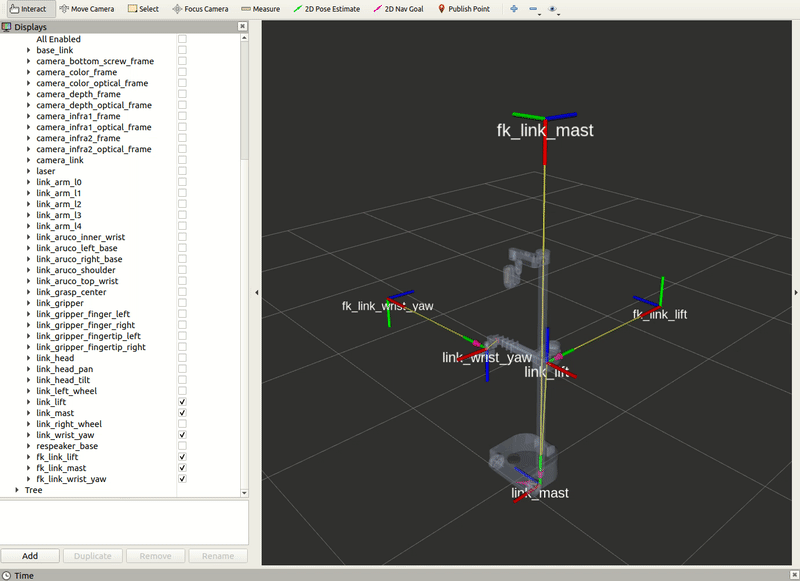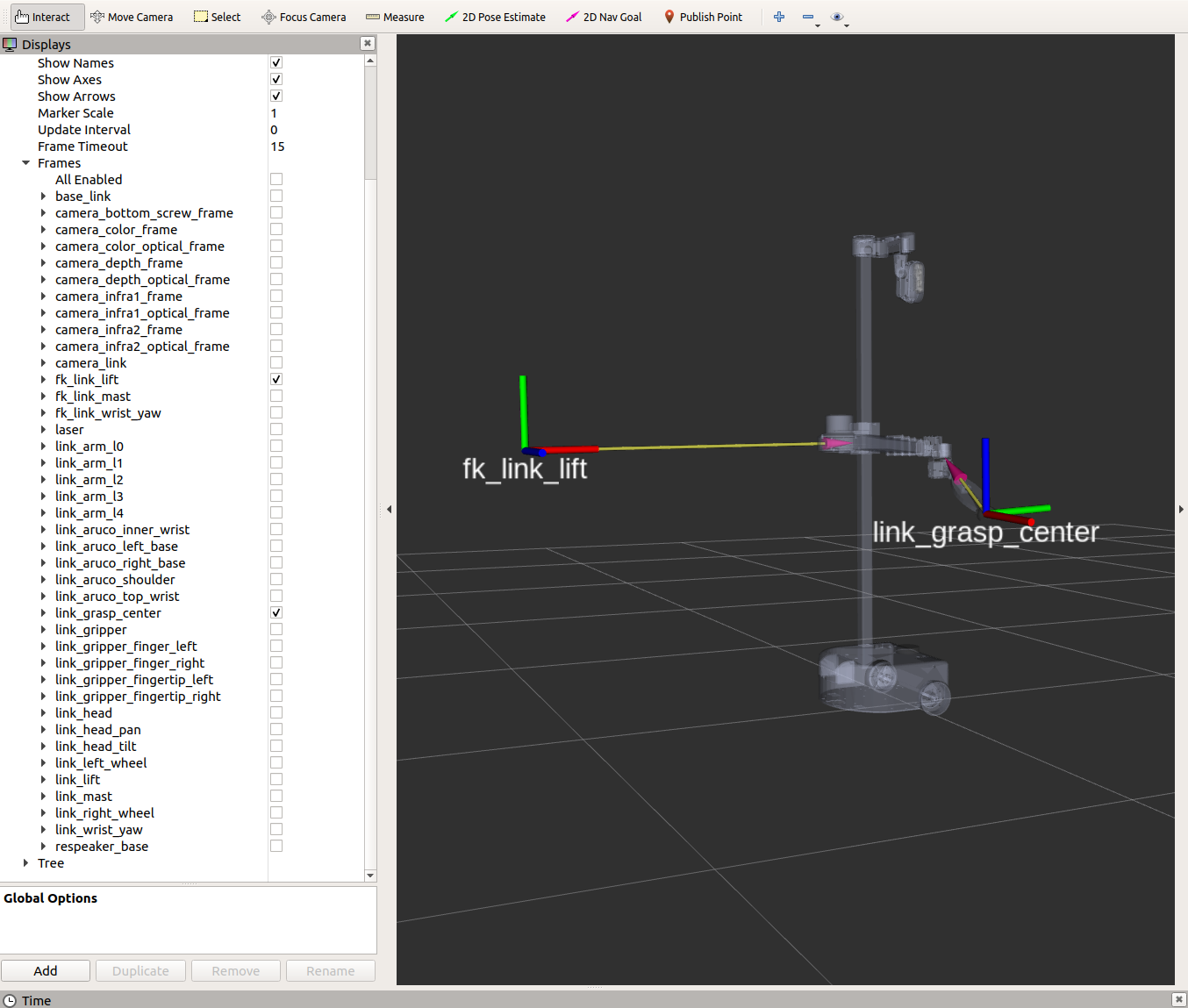Example 10
This tutorial we will explain how to create a tf2 static broadcaster and listener.
tf2 Static Broadcaster
For the tf2 static broadcaster node, we will be publishing three child static frames in reference to the link_mast, link_lift, and link_wrist_yaw frames.
Begin by starting up the stretch driver launch file.
roslaunch stretch_core stretch_driver.launch
Within this tutorial package, there is an RViz config file with the topics for the transform frames in the Display tree. You can visualize these topics and the robot model by running the command below in a new terminal.
rosrun rviz rviz -d /home/hello-robot/catkin_ws/src/stretch_tutorials/rviz/tf2_broadcaster_example.rviz
Then run the tf2_broadcaster.py node to visualize three static frames. In a new terminal, execute:
cd catkin_ws/src/stretch_tutorials/src/
python3 tf2_broadcaster.py
The GIF below visualizes what happens when running the previous node.

Tip
If you would like to see how the static frames update while the robot is in motion, run the stow_command_node.py and observe the tf frames in RViz.
In a terminal, execute:
cd catkin_ws/src/stretch_tutorials/src/
python3 stow_command.py

The Code
#!/usr/bin/env python3
import rospy
import tf.transformations
from geometry_msgs.msg import TransformStamped
from tf2_ros import StaticTransformBroadcaster
class FixedFrameBroadcaster():
"""
This node publishes three child static frames in reference to their parent frames as below:
parent -> link_mast child -> fk_link_mast
parent -> link_lift child -> fk_link_lift
parent -> link_wrist_yaw child -> fk_link_wrist_yaw
"""
def __init__(self):
"""
A function that creates a broadcast node and publishes three new transform
frames.
:param self: The self reference.
"""
self.br = StaticTransformBroadcaster()
self.mast = TransformStamped()
self.mast.header.stamp = rospy.Time.now()
self.mast.header.frame_id = 'link_mast'
self.mast.child_frame_id = 'fk_link_mast'
self.mast.transform.translation.x = 0.0
self.mast.transform.translation.y = 2.0
self.mast.transform.translation.z = 0.0
q = tf.transformations.quaternion_from_euler(1.5707, 0, -1.5707)
self.mast.transform.rotation.x = q[0]
self.mast.transform.rotation.y = q[1]
self.mast.transform.rotation.z = q[2]
self.mast.transform.rotation.w = q[3]
self.lift = TransformStamped()
self.lift.header.stamp = rospy.Time.now()
self.lift.header.frame_id = 'link_lift'
self.lift.child_frame_id = 'fk_link_lift'
self.lift.transform.translation.x = 0.0
self.lift.transform.translation.y = 1.0
self.lift.transform.translation.z = 0.0
q = tf.transformations.quaternion_from_euler(1.5707, 0, -1.5707)
self.lift.transform.rotation.x = q[0]
self.lift.transform.rotation.y = q[1]
self.lift.transform.rotation.z = q[2]
self.lift.transform.rotation.w = q[3]
self.wrist = TransformStamped()
self.wrist.header.stamp = rospy.Time.now()
self.wrist.header.frame_id = 'link_wrist_yaw'
self.wrist.child_frame_id = 'fk_link_wrist_yaw'
self.wrist.transform.translation.x = 0.0
self.wrist.transform.translation.y = 1.0
self.wrist.transform.translation.z = 0.0
q = tf.transformations.quaternion_from_euler(1.5707, 0, -1.5707)
self.wrist.transform.rotation.x = q[0]
self.wrist.transform.rotation.y = q[1]
self.wrist.transform.rotation.z = q[2]
self.wrist.transform.rotation.w = q[3]
self.br.sendTransform([self.mast, self.lift, self.wrist])
rospy.loginfo('Publishing TF frames. Use RViz to visualize')
if __name__ == '__main__':
rospy.init_node('tf2_broadcaster')
FixedFrameBroadcaster()
rospy.spin()
The Code Explained
Now let's break the code down.
#!/usr/bin/env python3
import rospy
import tf.transformations
from geometry_msgs.msg import TransformStamped
from tf2_ros import StaticTransformBroadcaster
You need to import rospy if you are writing a ROS Node. Import tf.transformations to get quaternion values from Euler angles. Import the TransformStamped from the geometry_msgs.msg package because we will be publishing static frames and it requires this message type. The tf2_ros package provides an implementation of a tf2_ros.StaticTransformBroadcaster to help make the task of publishing transforms easier.
def __init__(self):
"""
A function that creates a broadcast node and publishes three new transform
frames.
:param self: The self reference.
"""
self.br = StaticTransformBroadcaster()
Here we create a TransformStamped object which will be the message we will send over once populated.
self.mast = TransformStamped()
self.mast.header.stamp = rospy.Time.now()
self.mast.header.frame_id = 'link_mast'
self.mast.child_frame_id = 'fk_link_mast'
We need to give the transform being published a timestamp, we'll just stamp it with the current time, rospy.Time.now(). Then, we need to set the name of the parent frame of the link we're creating, in this case link_mast. Finally, we need to set the name of the child frame of the link we're creating. In this instance, the child frame is fk_link_mast.
self.mast.transform.translation.x = 0.0
self.mast.transform.translation.y = 2.0
self.mast.transform.translation.z = 0.0
Set the translation values for the child frame.
q = tf.transformations.quaternion_from_euler(1.5707, 0, -1.5707)
self.wrist.transform.rotation.x = q[0]
self.wrist.transform.rotation.y = q[1]
self.wrist.transform.rotation.z = q[2]
self.wrist.transform.rotation.w = q[3]
The quaternion_from_euler() function takes in an Euler angle as an argument and returns a quaternion. Then set the rotation values to the transformed quaternions.
This process will be completed for the link_lift and link_wrist_yaw as well.
self.br.sendTransform([self.mast, self.lift, self.wrist])
Send the three transforms using the sendTransform() function.
rospy.init_node('tf2_broadcaster')
FixedFrameBroadcaster()
The next line, rospy.init_node(NAME, ...), is very important as it tells rospy the name of your node -- until rospy has this information, it cannot start communicating with the ROS Master.
Note
The name must be a base name, i.e. it cannot contain any slashes "/".
Instantiate the FixedFrameBroadcaster() class.
rospy.spin()
Give control to ROS. This will allow the callback to be called whenever new messages come in. If we don't put this line in, then the node will not work, and ROS will not process any messages.
tf2 Static Listener
In the previous section of the tutorial, we created a tf2 broadcaster to publish three static transform frames. In this section, we will create a tf2 listener that will find the transform between fk_link_lift and link_grasp_center.
Begin by starting up the stretch driver launch file.
roslaunch stretch_core stretch_driver.launch
Then run the tf2_broadcaster.py node in a new terminal to create the three static frames.
cd catkin_ws/src/stretch_tutorials/src/
python3 tf2_broadcaster.py
Finally, run the tf2_listener.py node in a separate terminal to print the transform between two links.
cd catkin_ws/src/stretch_tutorials/src/
python3 tf2_listener.py
Within the terminal, the transform will be printed every 1 second. Below is an example of what will be printed in the terminal. There is also an image for reference of the two frames.
[INFO] [1659551318.098168]: The pose of target frame link_grasp_center with reference from fk_link_lift is:
translation:
x: 1.08415191335
y: -0.176147838153
z: 0.576720021135
rotation:
x: -0.479004489528
y: -0.508053545368
z: -0.502884087254
w: 0.509454501243

The Code
#!/usr/bin/env python3
import rospy
from geometry_msgs.msg import TransformStamped
import tf2_ros
class FrameListener():
"""
This Class prints the transformation between the fk_link_mast frame and the
target frame, link_grasp_center.
"""
def __init__(self):
"""
A function that initializes the variables and looks up a transformation
between a target and source frame.
:param self: The self reference.
"""
tf_buffer = tf2_ros.Buffer()
listener = tf2_ros.TransformListener(tf_buffer)
from_frame_rel = 'link_grasp_center'
to_frame_rel = 'fk_link_lift'
rospy.sleep(1.0)
rate = rospy.Rate(1)
while not rospy.is_shutdown():
try:
trans = tf_buffer.lookup_transform(to_frame_rel,
from_frame_rel,
rospy.Time())
rospy.loginfo('The pose of target frame %s with reference from %s is: \n %s', from_frame_rel, to_frame_rel, trans.transform)
except (tf2_ros.LookupException, tf2_ros.ConnectivityException, tf2_ros.ExtrapolationException):
rospy.logwarn(' Could not transform %s from %s ', to_frame_rel, from_frame_rel)
rate.sleep()
if __name__ == '__main__':
rospy.init_node('tf2_listener')
FrameListener()
rospy.spin()
The Code Explained
Now let's break the code down.
#!/usr/bin/env python3
import rospy
from geometry_msgs.msg import TransformStamped
import tf2_ros
You need to import rospy if you are writing a ROS Node. Import the TransformStamped from the geometry_msgs.msg package because we will be publishing static frames and it requires this message type. The tf2_ros package provides an implementation of a tf2_ros.TransformListener to help make the task of receiving transforms easier.
tf_buffer = tf2_ros.Buffer()
listener = tf2_ros.TransformListener(tf_buffer)
Here, we create a TransformListener object. Once the listener is created, it starts receiving tf2 transformations and buffers them for up to 10 seconds.
from_frame_rel = 'link_grasp_center'
to_frame_rel = 'fk_link_lift'
rospy.sleep(1.0)
rate = rospy.Rate(1)
The first line gives the listener some time to accumulate transforms. The second line is the rate at which the node is going to publish information (1 Hz).
try:
trans = tf_buffer.lookup_transform(to_frame_rel,
from_frame_rel,
rospy.Time())
rospy.loginfo('The pose of target frame %s with reference from %s is: \n %s', from_frame_rel, to_frame_rel, trans.transform)
except (tf2_ros.LookupException, tf2_ros.ConnectivityException, tf2_ros.ExtrapolationException):
rospy.logwarn(' Could not transform %s from %s ', to_frame_rel, from_frame_rel)
Try to look up the transformation we want. Use a try-except block, since it may fail on any single call, due to internal timing issues in the transform publishers. Look up transform between from_frame_rel and to_frame_rel frames with the lookup_transform() function.
rospy.init_node('tf2_listener')
FrameListener()
The next line, rospy.init_node(NAME, ...), is very important as it tells rospy the name of your node -- until rospy has this information, it cannot start communicating with the ROS Master.
Note
The name must be a base name, i.e. it cannot contain any slashes "/".
Instantiate the FrameListener() class.
rospy.spin()
Give control to ROS. This will allow the callback to be called whenever new messages come in. If we don't put this line in, then the node will not work, and ROS will not process any messages.